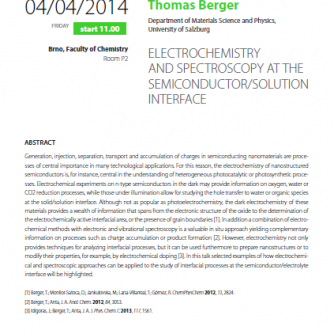Abstract:
Generation, injection, separation, transport and accumulation of charges in semiconducting nanomaterials are processes of central importance in many technological applications. For this reason, the electrochemistry of nanostructured semiconductors is, for instance, central in the understanding of heterogeneous photocatalytic or photosynthetic processes. Electrochemical experiments on n-type semiconductors in the dark may provide information on oxygen, water or CO2 reduction processes, while those under illumination allow for studying the hole transfer to water or organic species at the solid/solution interface. Although not as popular as photoelectrochemistry, the dark electrochemistry of these materials provides a wealth of information that spans from the electronic structure of the oxide to the determination of the electrochemically active interfacial area, or the presence of grain boundaries [1]. In addition a combination of electrochemical methods with electronic and vibrational spectroscopy is a valuable in situ approach yielding complementary information on processes such as charge accumulation or product formation [2]. However, electrochemistry not only provides techniques for analyzing interfacial processes, but it can be used furthermore to prepare nanostructures or to modify their properties, for example, by electrochemical doping [3]. In this talk selected examples of how electrochemical and spectroscopic approaches can be applied to the study of interfacial processes at the semiconductor/electrolyte interface will be highlighted.
[1] Berger, T.; Monllor-Satoca, D.; Jankulovska, M.; Lana-Villarreal, T.; Gómez, R. ChemPhysChem 2012, 13, 2824.
[2] Berger, T.; Anta, J. A. Anal. Chem. 2012, 84, 3053.
[3] Idígoras, J.; Berger, T.; Anta, J. A. J. Phys. Chem. C 2013, 117, 1561.








